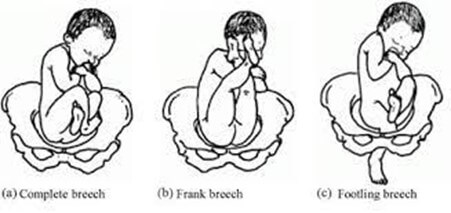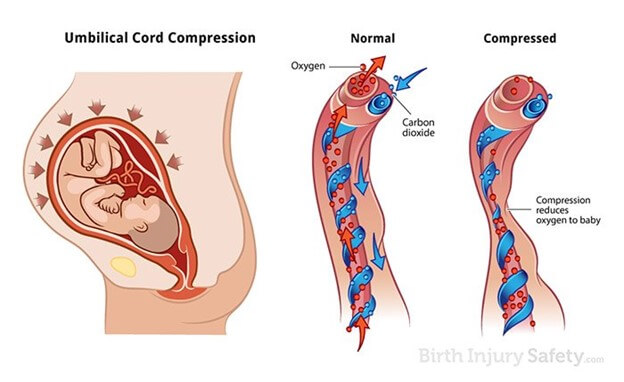Umbilical cord prolapse > Maternal & Newborn
Exam Review
Introduction
Total Questions : 5
Showing 5 questions, Sign in for moreA nurse is caring for a client who is in labor and has a breech presentation.
The nurse knows that this client is at increased risk for which complication?
Explanation
The correct answer is choice B. Cord prolapse.
A cord prolapse occurs when the umbilical cord slips through the cervix and into the vagina before the baby during labor.
This can cause the cord to become compressed or twisted, cutting off the blood supply and oxygen to the baby.A cord prolapse is a medical emergency that requires immediate delivery by cesarean section.
Choice A is wrong because placenta previa is a condition where the placenta covers the opening of the cervix, not the baby’s position.Placenta previa can cause bleeding during pregnancy and labor, but it is not directly related to breech presentation.
Choice C is wrong because shoulder dystocia is a complication where the baby’s shoulder gets stuck behind the mother’s pubic bone during a head-first delivery.
This can cause injury to the baby’s nerves, bones, or brain.Shoulder dystocia is not a common complication of breech delivery.
Choice D is wrong because postpartum hemorrhage is excessive bleeding after delivery.
It can be caused by many factors, such as uterine atony, retained placenta, or lacerations.Postpartum hemorrhage is not more likely to occur with breech presentation than with vertex presentation.
Breech presentation can also increase the risk of other complications, such as congenital malformations, developmental dysplasia of the hip, and traumatic injuries.
Therefore, most breech babies are delivered by cesarean section to reduce

A nurse is monitoring the fetal heart rate of a client who has ruptured membranes.
The nurse notices severe variable decelerations on the monitor.
What is the most likely cause of this finding?
Explanation
The correct answer is choice C. Umbilical cord compression.Variable decelerations are abrupt drops in the fetal heart rate below baseline that last 15 seconds to less than two minutes.They are caused by reduced blood flow and oxygen delivery to the fetus due to umbilical cord compression.The onset, depth, and duration of variable decelerations vary with uterine contractions or fetal movement.They can be periodic or episodic.
Choice A is wrong because fetal head compression causes early decelerations, which are symmetrical decreases and return-to-normal of the fetal heart rate that is linked to uterine contractions.Early decelerations are benign and do not affect fetal oxygenation.
Choice B is wrong because uteroplacental insufficiency causes late decelerations, which are gradual decreases in fetal heart rate after a uterine contraction.Late decelerations may indicate that a fetus has high levels of acid in the blood (a condition called impending fetal academia), which is often caused by a lack of oxygen.
Choice D is wrong because maternal hypotension can cause late decelerations, not variable decelerations.Maternal hypotension can reduce the blood flow to the placenta and affect fetal oxygenation.

A nurse is preparing a client for an emergency cesarean delivery due to cord prolapse.
What should the nurse do to relieve cord compression until the delivery?
Explanation
The correct answer is choice D. All of the above.
The nurse should do all of the following to relieve cord compression until the delivery:
• Apply gentle pressure to the presenting part with a sterile gloved hand.
This helps to lift the fetal head off the cord and restore blood flow.
• Elevate the client’s hips with pillows or a wedge.
This reduces the gravitational force on the cord and prevents further descent.
• Administer oxygen via facemask at 10 L/min.
This increases oxygen delivery to the fetus and reduces hypoxia.
A nurse is teaching a group of nursing students about cord prolapse.
The nurse explains that cord prolapse can be classified into three types: overt, occult, and funis.
What is the difference between these types?
Explanation
The correct answer is choice A.Overt cord prolapse is when the cord is visible or palpable in the vagina, occult cord prolapse is when the cord is hidden within the uterus, and funis cord prolapse is when the cord is alongside but not below the presenting part.
Choice B is wrong because it reverses the definitions of overt and occult cord prolapse.
Choice C is wrong because it reverses the definitions of overt and funis cord prolapse.
Choice D is wrong because it does not match any of the definitions of cord prolapse types.
Normal ranges for umbilical cord length are 45 to 60 cm, and normal ranges for umbilical cord diameter are 1 to 2 cm.
A nurse is reviewing the risk factors for cord prolapse with a pregnant client who has polyhydramnios.
The nurse should inform the client that polyhydramnios increases the risk of cord prolapse by which mechanism?
Explanation
The correct answer is choice B. It creates more space for the cord to slip past the presenting part.Polyhydramnios is a condition where there is excessive accumulation of amniotic fluid during pregnancy.This can cause the fetus to be malpositioned or not engaged in the pelvis before labor, which increases the risk of cord prolapse.Cord prolapse is when the umbilical cord drops into the vagina ahead of the baby, which can compromise blood flow and oxygen delivery to the fetus.
Choice A is wrong because it is not the fetal movement that causes cord prolapse, but the displacement of the presenting part from the cervix.
Choice C is wrong because it is not the pressure on the membranes that causes cord prolapse, but the rupture of the membranes with a high or mobile presenting part.
Choice D is wrong because it is not the reduced cushioning effect of the amniotic fluid that causes cord prolapse, but the increased space for the cord to slip past the presenting part.
Sign Up or Login to view all the 5 Questions on this Exam
Join over 100,000+ nursing students using Nursingprepexams’s science-backend flashcards, practice tests and expert solutions to improve their grades and reach their goals.
Sign Up Now

